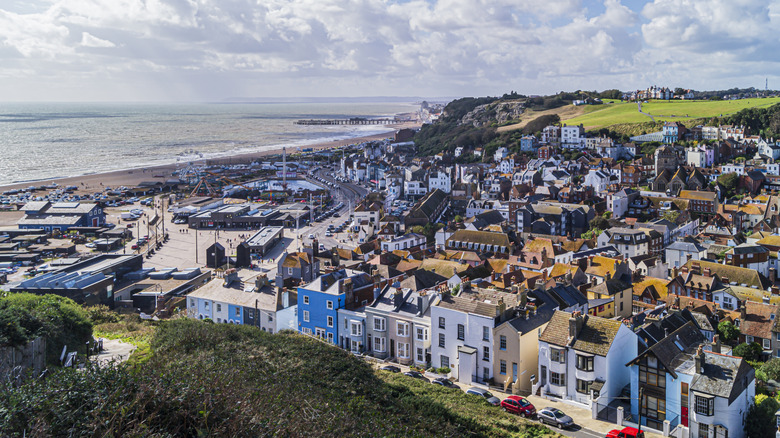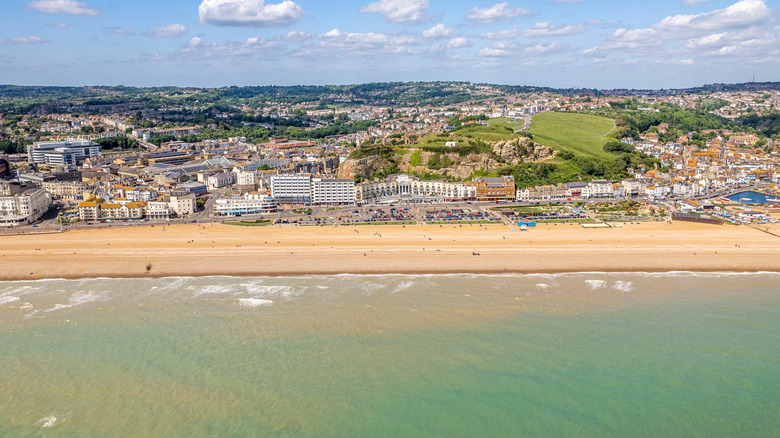England's Quirky Coastal Town Blends Old-World Charm With Seaside Fun (And It's More Than Just A Battle Site)
When the Duke of Normandy, William the Conqueror, landed at an unassuming beach on England's Sussex Coast in September 1066, his ambition was set firmly on the kingdom's contested throne. He couldn't have anticipated (or maybe he did?) that the ensuing battle would become arguably the most pivotal moment in English history. Almost a thousand years later, the seaside town of Hastings draws hundreds of thousands of visitors to see where England's future shifted. But those who look beyond the battle delight in the town's old-world charm and an experience of the quintessential British beach town.
Of course, the town's history can't be overstated. William's victory and subsequent ascension to the throne shaped the political, religious, linguistic, and economic future of the British Isles for centuries to come — even King Charles III, the current monarch, is directly related to him. Technically speaking, the battle took place seven miles outside of Hastings in what is now a small town named Battle (guess where it got its name?). But Hastings remains the symbol of the invasion and the trajectory of England for centuries to come.
But the modern Hastings is a delight unto itself. It boasts its own overlooked history beyond the battle, a thriving arts scene, natural wonders, and a bustling town center built to keep the quirkiest shoppers occupied for hours. It doesn't hurt that it's gorgeous to look at, too. Come for the history, stay for the unparalleled British beach town atmosphere. Plus, it's a lot quieter than the U.K.'s nearby nightlife capital, Brighton.
Plenty of seaside fun beyond the battle site
As mentioned, the battle site itself is actually in another town. It's well worth visiting for the stunning abbey built on the battlefield for more context, and exploring the town itself is a joy, but Hastings' offerings far surpass all that. Nestled between two cliffs, Hastings' Old Town looks torn from a medieval storybook. While most of the buildings are 19th-century, many stretch as far back as the 14th and are enjoying new lives as wander-worthy independent coffee shops, pubs, boutiques, and galleries. Don't forget to grab a ride up one of the two Victorian furnicular lifts at either end — you'll find Hastings Castle at the top of West Hill, and stunning views stretching out to the chalk cliffs of Beachy Head, once connected to the chalk cliffs found in Ault across the water, on East Hill.
The newer area (while still 19th century) is just as stunning. Originally developed as a separate resort town for upper-class Londoners, St. Leonards' shorefront is a masterclass in Victorian architecture. Its townhouses and newly rebuilt pier help foster a quintessentially British beach experience. Aside from the seaside aesthetic, St. Leonards has a burgeoning food scene, with cocktail bars, globally-inspired restaurants, and some excellent breweries emerging.
For the more adventurous, the St. Clements Caves, a four-and-a-half-acre underground labyrinth built into West Hill, are a standout attraction. Previously used by smugglers sneaking tea, rum, and other contraband into the country, they've since been used as air shelters in World War II, a venue for one of the Rolling Stones' earliest shows, and as a tourist attraction. There are even a number of outstanding museums centering on Hastings' fishing industry and a brilliant modern art gallery. In short, Hastings is far more than a name in a history textbook.
How to plan a trip to the coastal town of Hastings
With so much to see and do in Hastings, deciding how to spend your time will be the greatest challenge. Getting there is far easier. The U.K.'s public transport system is extensive, making it possible to get to Hastings town center from virtually anywhere. A direct train from London on the Southern or Southeastern lines takes around 90 minutes, depending on the specific train. If you're arriving at Heathrow, you'll need to get into London first and can expect to add another hour to the travel time. It would take around 2 hours to drive from the airport.
Hotel prices in Hastings are surprisingly affordable for the U.K. Opting to stay in a stunning 19th-century property like the Royal Victoria Hotel will average around $165 (£120), even in peak summer months as of 2025. Swinging towards one of the beautiful guest houses in the older part of town can cost as little as half that price. For more options, the closest major town is Eastbourne, about half an hour's drive or train away. Not far from there, you'll find this B&B lighthouse with sweeping cliff views.
Hastings might be better known for its historical significance, but the modern town is an off-the-beaten-track gem of a coastal town and more than worth a detour.


